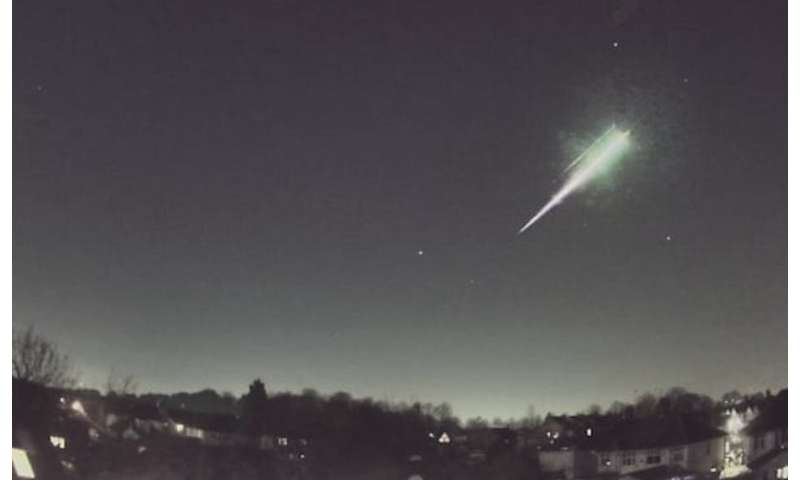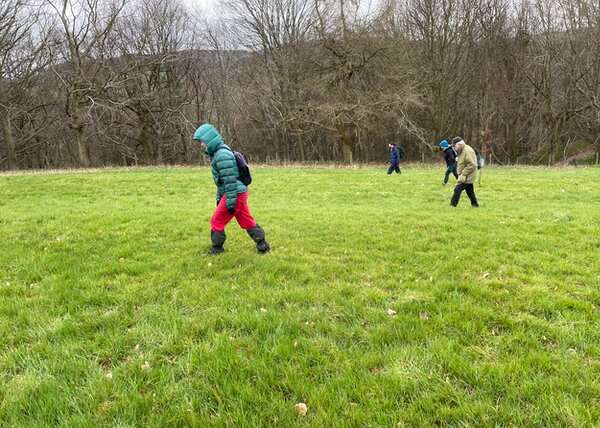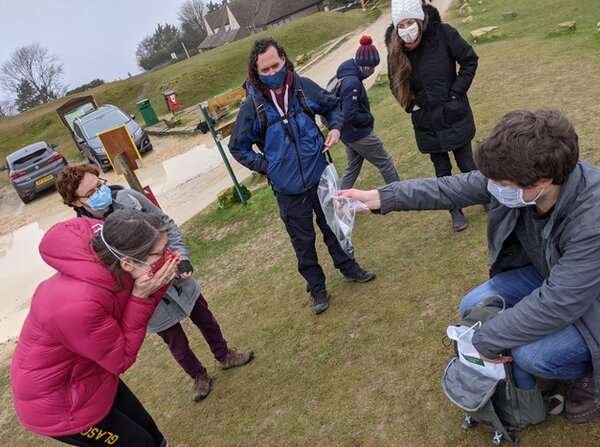Meteorite hunters: How we found the first bit of UK space rock in over 30 years

Wednesday 3 March started just like every other day in 2021. We were working from home. But by mid-afternoon, our colleague Luke had told us to pack our bags and fill our petrol tanks, just in case we got the OK to go on a meteorite hunt.
Four days earlier, a fireball had been spotted flying through the skies in the south of England. The flash had been captured on local people's doorbell video cameras. It was particularly bright—a sign that meteorites might be waiting to be found.
A piece of rock flying through space is called a meteoroid. When it enters Earth's atmosphere, causing a flash, what you see is a meteor. If any of the rock makes its way to Earth's surface, then it becomes a meteorite.
Finding fresh pieces of meteorite is extremely rare. Most meteors visible in the sky are caused by pieces of rock and dust the size of a grain of sand. A small number of these reach the ground as micrometeorites, but they're really hard to find.
They have to be much bigger to survive the journey through Earth's atmosphere—where they burn up and cause a flash—and make it to the ground in a big enough piece to be found.
This fireball was first seen on Sunday. By Wednesday, models showed with near certainty at least one meteorite had made it to the ground. The models centered on Winchcombe, a quiet village in Gloucestershire where a family had found a pile of black dirt on their driveway.
By this time, Richard Greenwood from the Open University had visited the family and confirmed it was a meteorite, but the maths told us there were more pieces to be found. We needed experts on the ground searching for fragments before they got contaminated by rain or trodden on by local wildlife.
Meteorite or sheep poo?
Our management team gave us the go ahead to make the trip, confirming that, as scientists doing our work, we weren't breaking lockdown rules. A team of around 15 researchers from across the UK descended on Gloucestershire on the morning of Thursday, March 4. We had a roughly 16km² area in which meteorites were most likely to have landed—known as a strewn field. We had less than a week to cover this area before heavy rain was forecast to hit.
As we would for any good fieldwork, we started by searching the fields. We systematically covered the land, by walking two meters apart—for maximum coverage as well as social distancing—in a long line going up and down.
We were looking out for small black shiny things on the ground. Given we were in the middle of the Cotswolds, this part wasn't so hard—there are many shiny black things left behind by the neighborhood sheep. This abundance of black shiny things did make finding the correct shiny black things really hard, though.
The search was also hindered by the presence of grass, dirt, trees and streams. This is why most meteorites have been recovered from Antarctica and deserts—it's much easier to spot dark black rocks against snow, ice or sand than it is to spot them in the English countryside.
Most sites of interest were on private land, but every landowner we met was lovely, respectful and understanding of the importance of our work, not to mention excited at the possibility that their field could be the one where a meteorite was recovered. We're hugely grateful to those who let us search their fields, and indeed the whole community for welcoming us at such a difficult time.

The big find
By Saturday, March 5 spirits were flagging. A few more piles of broken meteorite had been found in gardens or driveways, but we hadn't spotted any in the field. Our friend Mira Ihasz joined our search team. Mira lives with our search leader, Luke, which is why she was allowed to join the trip under lockdown rules.
She'd been working from her hotel room all week but now came to help us in the search, as an extra pair of eyes. She isn't a scientist, so whenever she spotted something she had to ask us to check it out.
That morning, Mira spotted eight meteor-wrongs. Then, the ninth thing Mira found, assuming it was yet another sheep poo, turned out to be the very thing we'd been hoping for—a meteorite at last.
It was the biggest piece anyone had found. We'd been lucky. It had landed in soft mud instead of on a hard driveway, so had stayed in tact.
Mira's fragment—as we fondly started calling it—is a beautiful specimen weighing over 100 grams. On its surface, you can even see marks from its passage through the Earth's atmosphere. The joy the whole team felt at the time was unmatched. We're all pretty certain this moment will be the highlight of our careers.

We were lucky to be able to travel for essential work. Please don't go searching during lockdown if it's not in your neighborhood. But if you are local to the Winchcombe area and you come across what you think might be a meteorite, there are a few things you can do.
- Take a photo of what you've found.
- Get the GPS coordinates of the location.
- Don't pick it up with your hands, as this would contaminate it with oil or skin particles.
- Don't touch it with a magnet, as this would erase crucial information about the magnetic history of the rock.
- Wrap it in aluminum foil or a clean freezer bag and store in a cool dry spot.
- Contact the Natural History Museum as soon as possible with a photograph.
If you do find a meteorite and it goes to the Natural History Museum, it will be part of a national collection archiving this historic event, studied by planetary scientists like us for decades to come.
Including Mira's fragment, more than 500 grams of he Winchcombe meteorite—as its official name will likely become—were found altogether. Its scientific importance of cannot be understated. It's a rare type, called a carbonaceous chondrite, with a parent body older than the Earth.
Planetary scientists are excited because carbonaceous chondrites are packed full of organic molecules, such as amino acids. These rocks may be the source of the ingredients for life on Earth. Thanks to the observational efforts of scientists and amateur astronomers, we were also able to calculate the trajectory of the meteorite and work out where it came from in the asteroid belt.
This article is republished from The Conversation under a Creative Commons license. Read the original article.![]() This story is part of Science X Dialog, where researchers can report findings from their published research articles. Visit this page for information about ScienceX Dialog and how to participate.
This story is part of Science X Dialog, where researchers can report findings from their published research articles. Visit this page for information about ScienceX Dialog and how to participate.